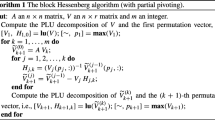Abstract
It is well-known that Bi-CG can be adapted so that the operations withA T can be avoided, and hybrid methods can be constructed in which it is attempted to further improve the convergence behaviour. Examples of this are CGS, Bi-CGSTAB, and the more general BiCGstab(l) method. In this paper it is shown that BiCGstab(l) can be implemented in different ways. Each of the suggested approaches has its own advantages and disadvantages. Our implementations allow for combinations of Bi-CG with arbitrary polynomial methods. The choice for a specific implementation can also be made for reasons of numerical stability. This aspect receives much attention. Various effects have been illustrated by numerical examples.
Similar content being viewed by others
References
Z. Bai, D. Hu and L. Reichel, A Newton basis GMRES implementation, University of Kentucky, Technical Report 91-03 (1991).
J.R. Bunch and L. Kaufman, Some stable methods for calculating inertia and solving symmetric linear systems, Math. Comp. 31 (1977) 162–179.
R. Fletcher, Conjugate gradient methods for indefinite systems, in:Proc. Dundee Biennial Conf. on Numerical Analysis, ed. G. Watson (Springer, New York, 1975).
R.W. Freund and N.M. Nachtigal, A transpose-free quasi-minimal residual algorithm for non-Hermitian linear systems, RIACS, NASA Ames Research Center, Technical Report 91.18 (1991).
G.H. Golub and C.F. Van Loan,Matrix Computations, 2nd ed. (The Johns Hopkins University Press, Baltimore and London, 1989).
M.H. Gutknecht, Variants of BiCGStab for matrices with complex spectrum, SIAM J. Sci. Comput. 14 (1993) 1020–1033.
C. Lanczos, Solution of systems of linear equations by minimized iteration, J. Res. Nat. Bur. Stand. 49 (1952) 33–53.
F. Leja, Sur certaines suites liées aux ensemble plans et leur application à la representation conforme, Ann. Polon. Math. 4 (1957) 8–13.
T.A. Manteuffel, The Tchebychev iteration for nonsymmetric linear systems, Numer. Math. 28 (1977) 307–327.
N.M. Nachtigal, L. Reichel and L.N. Trefethen, A hybrid GMRES algorithm for non-symmetric linear systems, SIMAX 13 (1992) 796–825.
Y. Saad, A flexible inner-outer preconditioned GMRES algorithm, SIAM J. Sci. Statist. Comput. 14 (1993) 461–469.
Y. Saad and M.H. Schulz, GMRES: A generalized minimum residual algorithm for solving nonsymmetric linear systems, SIAM J. Sci. Statist. Comput. 7 (1986) 856–869.
W. Schönauer,Scientific Computing on Vector Computers (North-Holland, Amsterdam/New York/Oxford/Tokyo, 1987).
G.L.G. Sleijpen and D.R. Fokkema, BiCGstab(l) for linear equations involving matrices with complex spectrum, ETNA 1 (1993) 11–32.
P. Sonneveld, CGS, a fast Lanczos-type solver for nonsymmetric linear systems, SIAM J. Sci. Statist. Comput. 10 (1989) 36–52.
K. Turner and H.F. Walker, Efficient High Accuracy Solutions with GMRES(m), SIAM J. Sci. Statist. Comput. 13 (1992) 815–825.
H.A. van der Vorst, Bi-CGSTAB: A fast and smoothly converging variant of Bi-CG for the solution of nonsymmetric linear systems, SIAM J. Sci. Statist. Comput. 13 (1992) 631–644.
R. Weiss, Convergence behavior of generalized conjugate gradient methods, PhD thesis, University of Karlsruhe (1990).
J.H. Wilkinson,The Algebraic Eigenvalue Problem (Oxford University Press, Oxford, 1965).
D.M. Young and K.C. Jea, Generalized conjugate-gradient acceleration of nonsymmetrizable iterative methods, Lin. Alg. Appl. 34 (1980) 159–194.
L. Zhou and H.F. Walker, Residual smoothing techniques for iterative methods, SIAM J. Sci. Comput. 15 (1994) 297–312.
Author information
Authors and Affiliations
Additional information
Communicated by C. Brezinski
Rights and permissions
About this article
Cite this article
Sleijpen, G.L.G., van der Vorst, H.A. & Fokkema, D.R. BiCGstab(l) and other hybrid Bi-CG methods. Numer Algor 7, 75–109 (1994). https://doi.org/10.1007/BF02141261
Received:
Revised:
Issue Date:
DOI: https://doi.org/10.1007/BF02141261
Keywords
- Bi-Conjugate gradients
- non-symmetric linear systems
- CGS
- Bi-CGSTAB
- iterative solvers
- ORTHODIR
- Krylov subspace




